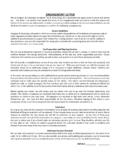Transcription of ON RULES OF ENGAGEMENT - International …
1 SANREMO HANDBOOK. ON. RULES OF ENGAGEMENT . Prepared under the auspices of the International Institute of Humanitarian Law, Sanremo Drafting Team Commander Alan Cole United Kingdom Royal Navy Major Phillip Drew Canadian Forces Captain Rob McLaughlin Royal Australian Navy Professor Dennis Mandsager Captain, JAGC, Navy (Retired). Naval War College Editor and Project Coordinator Sanremo, November 2009. This handbook does not necessarily represent the views of either the International Institute of Humanitarian Law or the government of any member of the drafting team FOREWORD. The Sanremo Handbook on RULES of ENGAGEMENT is intended to continue in the same vein as previous well-known Sanremo publications such as the Sanremo Manual on International Law Applicable to Armed Conflicts at Sea, published in 1995 and the Sanremo Manual on the Law of Non- International Armed Conflict, published in 2006. Published by the Institute as a working tool, the booklet is not intended to state the official opinions or positions of individual governments nor of specific International organisations on the different issues considered.
2 Its only aim is to guide the reader and in particular the participants in the military courses of the International Institute of Humanitarian Law . through the intricacies of the generally accepted and widespread concept of RULES of ENGAGEMENT . The Handbook reflects the results of a three-year project initiated by Professor Dennis Mandsager of the United States Naval War College, with the full support of the Institute, who identified the need for a common RULES of ENGAGEMENT reference that could be used by any nation for training and/or operations. The Handbook was informed by several workshops conducted at the International Institute of Humanitarian Law, Sanremo, plus numerous multinational exercises and courses, which drew input from highly qualified experts from different regions of the world. The Handbook, in its current form, reflects best practice from nations across the globe. The text has been prepared by Commander Alan Cole RN, Major Phillip Drew, Canadian Forces, Captain Rob McLaughlin, RAN and Professor Dennis Mandsager, Captain, JAGC, US Navy (Ret.)
3 The final draft has been reviewed by a team of Council members of the Institute, composed of Brigadier General Erwin Dahinden, Dr. Baldwin de Vidts, Professor Wolff Heintschel von Heinegg, Professor Marie Jacobsson, Dr. Michael Meyer and Professor Michel Veuthey, with the cooperation of Colonel Darren Stewart, Director of the Military Department of the Institute. There are no other Handbooks of its type in existence; it has been designed so that it can be used by any nation or group of nations without reference to security caveats or restrictions. Of course this was always the intent, to provide a tool that could be used to facilitate and enhance multinational cooperation and mutual understanding while ensuring that military forces are in compliance with national security and policy concerns. As the political control on the use of force and with that, the use of RULES of ENGAGEMENT to regulate the conduct of armed forces by individual nations, alliances and coalitions around the world continue to grow, so too the need to be able to train on and understand RULES of ENGAGEMENT similarly gains importance.
4 It is essential that a clear understanding exists that whilst RULES of ENGAGEMENT are often a mix of military and political policy requirements, these must be bounded by extant International and domestic legal parameters. Such legal constraints may never be exceeded, but are quite often restricted further by the effect of RULES of ENGAGEMENT . Too often national or multinational security classifications mean that ii . the publication and sharing of RULES of ENGAGEMENT experience and best practice is problematic. The ability for militaries to share their experiences as well as for academics, students and the public to consider the subject is critical in order to promote awareness of the practical implementation of International Humanitarian Law through RULES of ENGAGEMENT . The new Handbook will meet the requirements of our military courses, but it will be equally available to other interested institutions and parties.
5 It is my sincere hope that the Handbook will find a use either in those areas of the world where RULES of ENGAGEMENT doctrine does not currently exist or as a vehicle to aid in the creation of realistic and meaningful exercises at the national and multi-national level. The Handbook is intended to be of assistance to those working both at the strategic level, to aid in the preparation of clear and unambiguous RULES of ENGAGEMENT , as well as for those involved in their implementation in order that RULES of ENGAGEMENT are issued in a language that is easily understood and that assists military personnel's ability to accomplish the mission. Given that this is an area which is constantly changing, reflecting the nature and manner in which nations participate in military operations, we fully expect users of the Handbook to come up with suggestions to refine and hone the practice articulated in the Handbook in future editions of the text.
6 I should very much like to thank Professor Dennis Mandsager, who was the originator of the initiative, the Drafting Committee of the Handbook, as well as all the members of the Institute (including Professor Natalino Ronzitti and Vice Admiral Ferdinando Sanfelice di Monteforte) who, on a personal basis, gave useful comments and suggestions. Finally, my thanks go to the International Committee of the Red Cross (ICRC). Its substantial financial contribution facilitated not only the fast publication of the Handbook and its translation into other languages, but also allows the IIHL to distribute the Handbook to all interested students and institutions. Ambassador Maurizio Moreno President, IIHL. iii . PREFACE. The Naval War College, like many similar schools, conducts unclassified and classified research, teaching, war games, and conference and has an International student body. When the topic involves RULES of ENGAGEMENT (ROE) and when the participants represent multiple nations, meaningful discussion is problematic.
7 Participants often arrive with either little knowledge of ROE, or with knowledge of a classified national set of ROE that is not releasable to other nations, or with knowledge of a set of classified multinational ROE that is not releasable outside a coalition. The goal of this ROE Handbook project was to alleviate that problem by developing a realistic, comprehensive, and unclassified ROE Handbook that is usable by all nations for training, education, exercises, war games, and real world operations. The first step in the drafting process was to identify counterparts in Australia, Canada, and the United Kingdom, with whom the College already had a close working relationship, to join the drafting team. The second step was to join forces with the International Institute of Humanitarian Law (IIHL) and its large International student body to test Handbook drafts in teaching and workshop environments.
8 The challenges for the drafting team were considerable. Many questioned the feasibility of developing an ROE that would be acceptable to the International community. Nations have different treaty obligations, different views on International law, different views on policy, and different views on the authority and responsibility of commanders. Additionally, almost all reviewers believe that real world ROE must be classified. The drafting team produced multiple drafts, which were critiqued at many varied venues, including two multinational ROE workshops and two naval operations courses held at IIHL. The result at each event was robust ROE play. After three years of drafting and testing, the IIHL Council approved publication of the Handbook in September of 2009. The format of the Handbook is unique in that, in addition to ROE measures, it includes formats for a wide range of ROE-related matters, including ROE cards, warnings, responses to warnings, and other matters.
9 The drafting team recognises that many nations have their own formats for these items; however, many do not, and students often do not have access. The Handbook contemplates that, in a multinational force, higher authority in each nation will approve ROE for its forces and that each multinational partner will comply with national law and policy. Accordingly, the Handbook provides multiple, and often inconsistent, options for ROE measures. Consensus on each measure is not critical. Sharing ROE. information with the multinational force commander, however, is critical. The drafters request that users of the Handbook share constructive criticism, questions, and comments, as well as any lessons-learned from ROE exercises. Please email them to Dennis Mandsager Naval War College iv . ACKNOWLEDGEMENTS. The drafting team expresses its thanks to the International Institute of Humanitarian Law and to the countless students, workshop participants, and counterparts who have used the Handbook and have provided constructive criticism and recommendations for improvement.
10 Alan Cole thanks Commodore Neil Brown, Royal Navy for his support both through making him available from his staff and for his own personal contribution notably in the drafting of sections related to pre-planned targeting. He also thanks Captain Andrew Jameson Royal Navy who contributed on maritime security matters. Rob McLaughlin could not have been involved in this project without the strong support of Rear Admiral Allan du Toit, Major General David Morrison, and Commodore Trevor Jones, to whom he expresses his thanks. He also expresses his thanks to the many operations and legal officers within the ADF, and in particular, Wing Commander Ian Henderson, for their reviews and comments. Phillip Drew would like to extend his thanks to the Commander of the Canadian Defence Academy, Major-General Daniel Gosselin and the Judge Advocate General of the Canadian Forces, Brigadier-General Kenneth Watkin, for their strong support from the inception of this project through to its completion.







